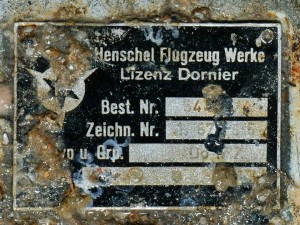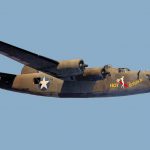
(Image Credit: Trustees of the Royal Air Force Museum)
The Donier Do 17 that the RAF Museum recently retrieved from under 50 feet of salt water where it had lain for over 70 years, arrived at the museum’s Cosford facility today. Museum staff as well as members of the public were on hand as the two tractor trailers that were carrying the wings and fuselage rolled through the museum’s gates having taken on the plane at Ramsgate, UK where its salvage barge was docked.
(Image Credit: Trustees of the Royal Air Force Museum)
(Image Credit: Trustees of the Royal Air Force Museum)
Shortly after its arrival, a crane lifted the custom-designed frames supporting the remains of the WWII Luftwaffe light bomber from their transport trailers in preparation of their placement into special hydration tunnels that will keep the aircraft bathed in a citric acid, halting and neutralizing the corrosion of the aluminum plane, the first step in the restoration of this sole complete remaining example of its type.
In light of the attention the retrieval and restoration project has received, both in the United Kingdom and around the world, the museum will allow the public to come view the aircraft tomorrow, June 16th starting at 10AM. It’s anticipated that aviation fans from across England’s Midlands will want to head to the Museum to catch a glimpse of the aircraft.
Alex Medhurst, the General Manager at RAF Museum Cosford stated: “After all the hard work, planning and setbacks, it’s great to know the Dornier is finally here at Cosford. It will be a rare and exciting opportunity for visitors in the Midlands to get up close and personal to a unique piece of aviation history and the chance to view it in its salvaged state.”
(Image Credit: Trustees of the Royal Air Force Museum)
The Dornier Do 17, shot down 72 years ago during the Battle of Britain and quickly buried under the ever-shifting sands off the coast of Kent, was discovered in diver five years ago and has been the subject of unending interest since. As the sole complete example of a widely-produced plane of extreme historical significance, the RAF Museum has gone to great lengths and expense to retrieve it. When raised from the seabed, the surviving data plate still attached to the fuselage confirmed the plane’s identity as: Dornier 17 Z-2 Serial No 1160 of 7 Staffel, III Gruppe/KG3 (7th Squadron of the 3rd Group of Bomber Wing 3), Coded 5K + AR, just the museum’s research had indicated.
Operating out of the Saint-Truiden Air Base in Belgium, 5K + AR was one of seven in its formation on August 26, 1940, carrying sixteen 50kg bombs that it was tasked to drop on the RAF Fighter Command airfields in the area of Medway, in Southeast England. Before reaching it’s target, Dornier 17 became separated from the rest of the formation and lost its bearings. It was then attacked by RAF Boulton Paul Defiants from the 264 Squadron. Both engines were hit as was the cockpit. With at least one of their engines stopped, a forced landing was made on the Goodwin Sands.
The crew of the downed craft all managed to exit the plane. The pilot, Flight Sergeant Willi Effmert, was captured, as was Sergeant Herman Ritzel, both sitting out the remainder of the war in a POW camp, while two others, Wireless Operator, Sergeant Helmut Reinhardt and Bombardier, Corporal Heinz Huhn died from their injuries. Huhn, who’s gravesite is located in Cannock Chase German War Cemetery in the UK, received a visit from Medhurst of the RAF Museum last week, who laid a wreath in honor of “all those young men, from across the world, who died in the service of their country.”
Here is the Video:



























